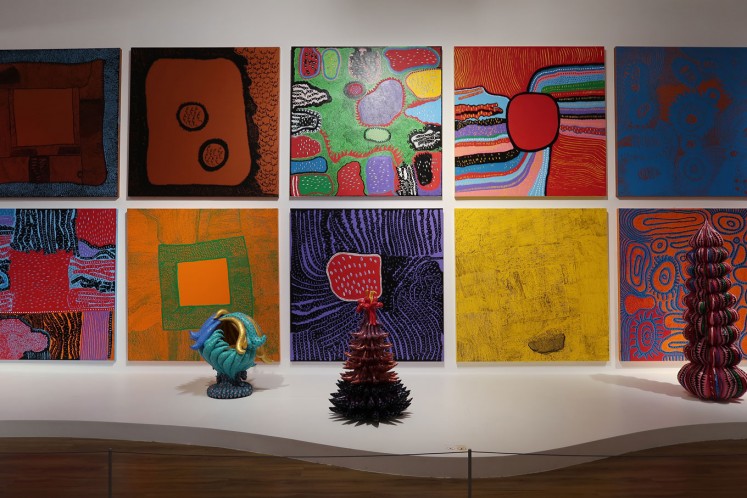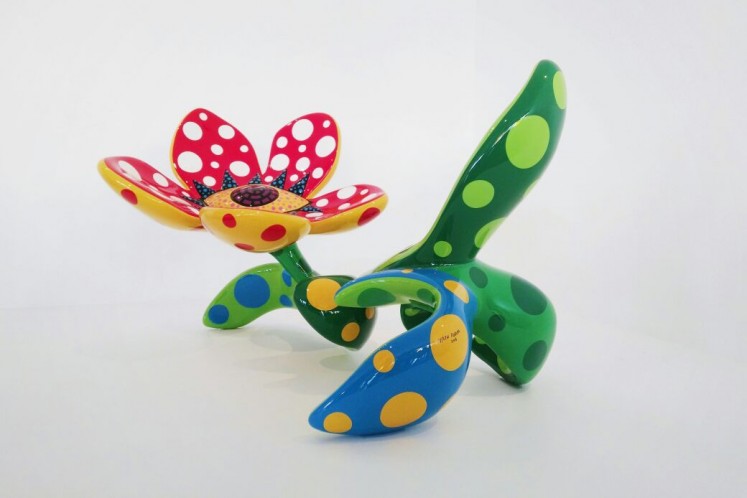Popular Reads
Top Results
Can't find what you're looking for?
View all search resultsPopular Reads
Top Results
Can't find what you're looking for?
View all search resultsYayoi Kusama: Her world of polka dots
Yayoi Kusama’s masterpieces mostly come out of her passion for dots.
Change text size
Gift Premium Articles
to Anyone
It is said people with brilliant minds are eccentric and 89-year-old Yayoi Kusama is no exception — she is obsessed with dots.
Her dots may appear boring, but she has this incredible ability to create enchanting artwork of many variations with just the dots. There is no trial and error in her work, no stimulation or test, what she paints is in one go.
The repetitive dot paintings, yellow pumpkin motifs, mirror room and her soft sculptures define her work.
The artist’s usage of space, varied mediums, experimentation with vibrant colors and eye-catching installations have revolutionized the contemporary art world, and she is now considered one of the most influential and highest-paid living female artists of contemporary art.
A longtime associate of Kusama, Akira Tatehata, curator of the Kusama Museum in Tokyo that was inaugurated by the artist last year, was in Jakarta recently to deliver a lecture on Yayoi Kusama’s world — her artistic journey and unique psychological condition.
“Her artwork is characterized as simple yet complex,” Tatehata said about the Japanese artist’s work in an interview with The Jakarta Post.
The highly acclaimed exhibition at the Museum of Modern and Contemporary Art in Nusantara (MACAN), titled Yayoi Kusama: Life is the Heart of a Rainbow, is the third and last stop following exhibitions at National Gallery Singapore and Queensland Art Gallery | Gallery of Modern Art in Australia. The exhibition at Museum MACAN, which is open until Sunday, showcases some 130 works of the artist spanning almost 70 years.
The series gives insight into the important periods of the artist’s career and life.
The iconic Infinity Mirrored Room — Brilliance of the Souls ( 2014 ) has been on display since November 2017, a popular piece that was part of the museum’s inaugural exhibition, Art Turns. World Turns.
Yayoi Kusama, Museum Macan, August, Jakarta, 2018. (JP/Liza Yosephine)The current exhibition includes My Eternal Soul, Dots Obsession, Narcissus Garden, The Spirits of the Pumpkins Descended into the Heavens and I Want to Love on the Festival Night.
The famed The Obliteration Room — an interactive installation that has toured more than 20 venues in 15 countries and has been viewed by almost 5 million people, is also part of the exhibit.
There are also pieces on display that were not included in the previous two locations, such as Flower ( 1953 ) and Untitled/Child Mannequin ( 1966 ).
Tatehata observed that contradiction is a part of Kusama’s artistic journey. “She desires for herself to be obliterated, as apparent in some of her works. On the other hand, she also has a lot of self-admiration, sometimes to a point of narcissism,” he said.
Museum MACAN published the first publication of Kusama’s works in Indonesian as part of the museum’s goal to present not only an exhibition but complete it with a book as an educational tool for the future generation.
Yayoi Kusama’s compulsive use of dots began as the result of the many unsettling “hallucinations” and “visions” she had while growing up. She was terrified by the vivid visions of the reoccurrence of dots in floral patterns and bright lights that consumed the room to the extent that she felt being obliterated.
She was soon diagnosed with suffering from a debilitating psychiatric disorder. She was encouraged to draw and paint as a therapy to give release to her oppressive feelings. This is where she found her salvation.
There is a poignant reason behind Kusama’s mental disorder. She had a difficult childhood. Kusama did not get along with her mother, a dominating lady who was against Kusama’s intention to pursue art since very early age, upsetting Kusama and eventually affecting her mentally.
Tatehata, who passionately believes in Kusama’s artistic talent, recalled his first encounter with the famed artist back in 1976, when he was just a young guy of 28 while attending an exhibition of her works at a gallery in Ginza, Tokyo.
'Flower' by Yayoi Kusama. (JP/Muthi Kautsar)After a successful stint in the United States, Kusama returned to Japan due to her mental deterioration, perpetuated by the passing of her longtime partner Joseph Cornell, among other issues.
Tatehata recalled how apprehensive he was to approach her — this was not just because of her fame but also because of the bad reputation Kusama had earned for herself, especially in her homeland, Japan.
Young Kusama had created quite a buzz back in the 1960s when she went all naked in New York to protest against the Vietnam War. Conservative Japanese society of the time was appalled, and she was labeled the “Queen of Scandals” by the mainstream media.
She was widely misunderstood but stood by her strong condemnation of war of any kind and spread the message of universal love through her artwork.
“It is that kind of sincerity that is visibly reflected in her work,” says Tatehata who was taken in by Kusama’s pure intentions and became one of her greatest champions.
He took it upon himself to help transform her image from a “streaker” to one of the most admired artists of the century by letting her works do the speaking.
The fact that it hasn’t been an easy journey for the Japanese artist is also revealed in the documentary Infinity, which is set to be released later this year.
Over the years, Kusama has evolved as an artist. From a monochrome artist in her early days, she became a colorist artist by the 2000s, using brilliant colors in her works. “She also moved from figurative work to abstract work,” adds Tatehata.
Shedding light on Kusama as a person, Tatehata admits that, while Kusama as a person is very charming, she can also be difficult at times. However, a little convincing is all that is needed to win her over.
The artist, who never married and has no family, is said to be lonely and craving love. The only escape from her loneliness is what she loves to do the most — painting dots and more dots.













